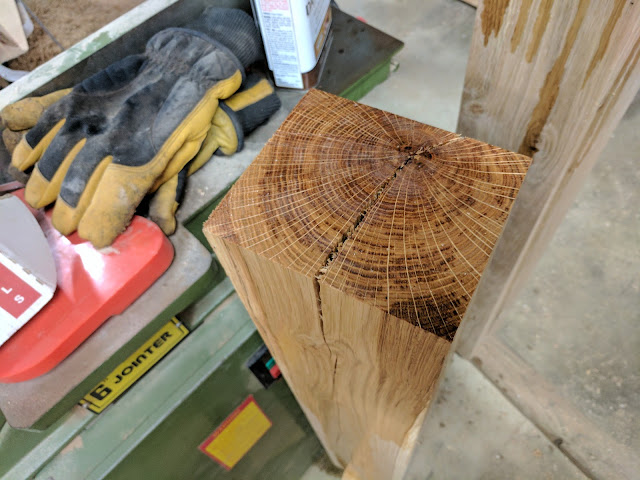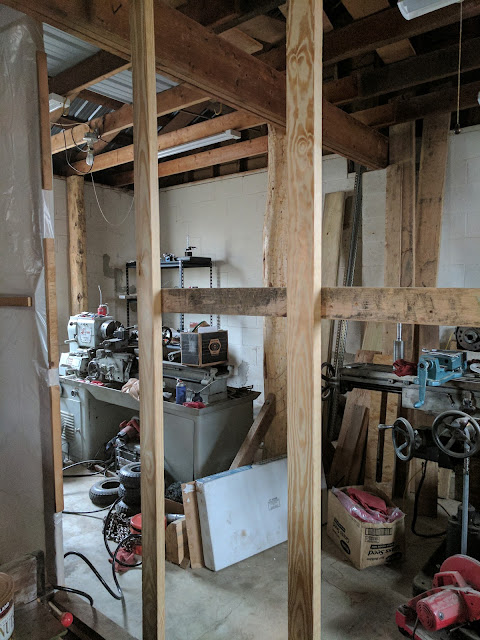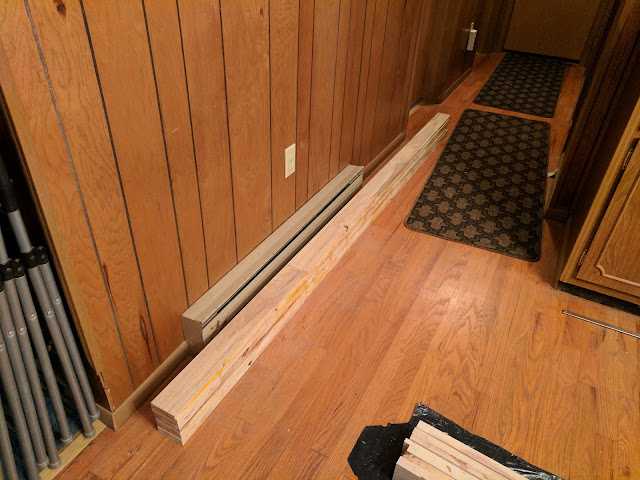Workbench-base re-re-design
I bought a lot of tools and equipment this week to aid me in doing the mortise and tenon needed to construct the workbench base. My original plan was to put mortises right into the workbench top for the legs (the legs would have the tenons). The more I thought about this the more I disliked it. "Damaging" the workbench top, those big tenons, lack of support for the center of the workbench top, just too many bad feelings about this design. So I went online again and searched youtube for answers. I looked at Paul Seller's workbench build in particular. Most of the youtubers that I trust used standard stretchers to support the top and simply laid the top on the stretchers with minimal attachment - no glue either so that the top could be changed out when damaged too much to redress.
So, I moved to a design where I have two top stretchers on the short ends of the table and none on the long side. I also decided to use half-lap joints since these are easier to make!
So I proceeded to joint, plane, and notch the base member pieces. I really should have used a dado cutter on the radial arm saw to cut the notches, but it was so buried in crap that I decided to just use the router with some simple guides and the planer bit that I used to flatten the top. I had some trouble keeping the guides clamped to the piece due to the size and location of the pieces. I moved from the clamps to simply air-nailing in the guides directly to the piece. It worked well, but the problem came when I tried to remove the nails - they broke off when trying to pull them from that hard oak! So I simply cut the nails as close to the wood surface as possible and them counter-punched them in as best I could. I can fill those defects with wood-filler if I want to later. There are a lot of defects in the leg wood anyway - damn wood-borers!
 |
| It's just loose fitted here - no glue or fasteners yet. I just wanted to make sure I had everything ready. Too cold to glue now anyway. |
 |
| Not furniture quality joints, but plenty good enough for a workbench! |
 |
| Here you can see a split out in the top stretcher. The strength should not be affected too much, but its kinda ugly. I might glue this back in and fill with wood filler. |
Hand plane experiences
I bought a cheap handplane off of amazon - a Stanley #4 bevel down general purpose plane. By cheap I mean it was on the order of $20. After unpacking it I read that the blade should be honed before use. So I took the blade off and tried my hand at honing it! I also got a blade guide and new sharpening stones this week! The guide and stones worked well and I got the blade nice an sharp in less than an hour. I set the blade and that's where I found some issues. The blade set on this plane is just a knurled screw on a flat piece of metal to form a compression fit. It uses two guide screws to adjust the blade depth and alignment. It is VERY difficult to get the depth set and aligned, and once you have that tightening of the locking mechanism tends to push the blade off center! When I look at the high-end planes I see that they have a completely different type of mechanism on the "frog" (common language for the blade holding mechanism in a hand plane). I also noticed that the high-end planes that do what I want are on the order of $200!While getting our pups groomed this weekend we stopped into a "thrift store" like place that supports local pet rescue. The manager the (Dave something) said that every once in a while he will get in some Amish tools and they will often have some decent hand tools like planes, etc.! I left my number for him to call me when he gets some in! I should really scour ebay too, I suppose.
Sharpening chisels and other blades..
I also tried my hand at sharpening some wood chisels. I tried using some of the new chisels that I bought this week and was not impressed. Then it occurred to me that I was probably supposed to hone them before use (just like the plane blade)! Besides general sharpness desires, I also needed to sharpen some of my chisels due to abuse (a couple were highly dented and dinged!)
For the highly damaged chisel blades I used a belt sander to grind off the uneven dings. Then I used a coarse stone and my sharpening guide tool to put back on a 25 degree bevel, then a finer stone to put on the 30 degree cutting edge. The first 3 chisels went pretty well, but by the 4th something went wrong and I couldn't get a consistent flat surface on my blade. I suspect that this may have to do with the coarse stone having gone a bit concave due to wear. I am going to try flattening the coarse stone next time to see it that helps.




















































































